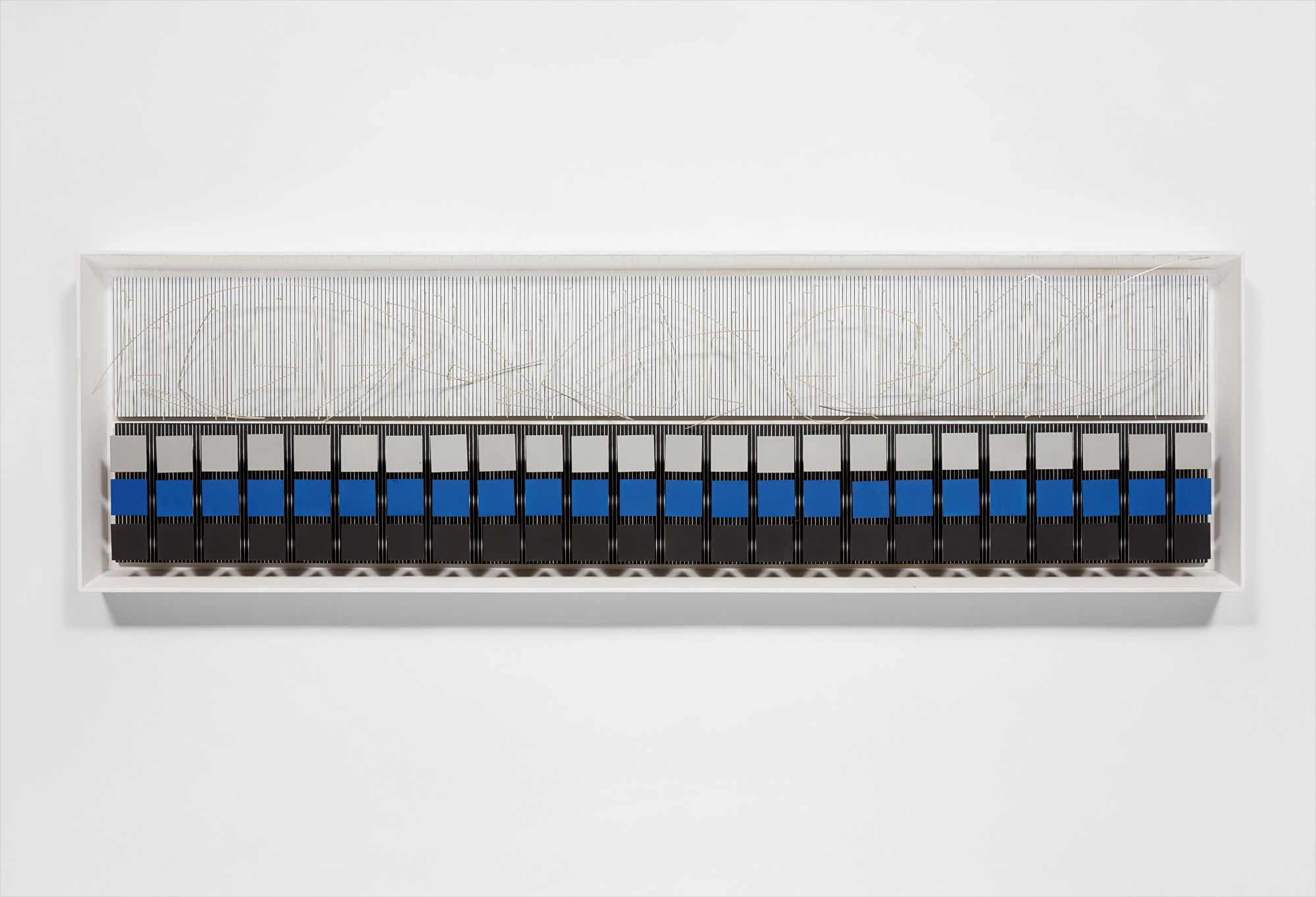

16
Jesús Rafael Soto
Cuadrados y escritura blanca
Full-Cataloguing
Soto was raised in the small regional capital of Ciudad Bolivar, where he had very limited exposure to art and an unconventional training in the field. Soto began working at the age of sixteen at a local movie theater making signs. He would paint these signs using powdered pigments that included cobalt blue, black, white, olive green and brick red. These colors would later characterize his works becoming, as he said, “engraved on my retina... they are also the ones that work the best in my creations” (A. Jiménez, Conversaciones con Jesús Soto, Fundación Cisneros, Caracas, 205, p. 142). These movie theater signs were the impetus that led him to begin producing his own work. After his friends recognized his talent they helped him obtain a scholarship at the School of Visual and Applied Arts in Caracas. During this time, Soto met the group of Venezuelan artists and intellectuals, Los Disidentes, among whom Alejandro Otero and Carlos Cruz-Diez became his mentors. Very early on in his studies Soto proved to have an incredibly acute understanding of modernist concepts such as light, time, movement and space, which he incorporated into his unique brand of kinetic and op art.
For most artists the movement toward abstraction was through a gradual and thorough pictorial process. However, for Soto—who was influenced by Kazimir Malevich and Piet Mondrian’s work—abstraction was a concept and position he immediately adopted as a starting point of his own practice. Malevich’s painting White on White, (1918), became a constant inspiration after Soto initially learned about it only through a verbal description by a friend who had seen it in New York. He immediately understood the vital importance of it: “the purest and most perfect form for capturing light in a canvas.” (A. Jiménez, Conversaciones con Jesús Soto, Fundación Cisneros, Caracas, 205, p. 151). Through these two artists Soto learned how they arrived at abstraction through Cubism. Yet Soto not only wanted to appreciate abstraction, which he considered the most important movement of the twentieth century, he wanted to move it forward.
As a result, Soto abandoned pictorial representation and instead took his work into a different dimension. He began organizing the pictorial surface differently through repetition and progression. He also explored vibration through repetition to break away from composition and balance—essential codes in figurative art. He rid his works of composition so that they became fragments of the universe, and with them attempted to capture a precise moment in time. The vibrations in these repetitions represent light; light as the essence of everything rather than theme, object or form. Soto was also obsessed with squares, which he considered the most important geometric form because they lacked a specific dimension and were a purely intellectual creation of man. Hence, squares are a constant in his body of work, and by superimposing white and black squares he made movement visible in them. He also incorporated new materials such as Plexiglas and metal.
By the mid-1950’s, Soto had produced only a few pieces, which were of a very high quality and sophistication, forming a coherent body of work that posed and solved problems with methodical precision. He also started using what he called weaving lines, a repetition of parallel lines placed very close together, superimposed with cubes - which produced a spatial ambiguity that would characterize his later works, such as the the present lot.
From 1958-1967, Soto conceived works that belong to one of the most important periods of his oeuvre, which he labeled “baroque.” It is in this period that he began to incorporate the writings, las escrituras, as depicted in Cuadrados y escritura blanca (1979). The intention of these works was to draw in space and to free himself from being bound to the rigidity of parallel lines, while still maintaining a kind of geometric rigor. This also enabled him to incorporate curves into his works, similar to the ones he used in his early abstract landscapes. Another facet of his oeuvre is the use of found objects like wire and wood in order to, as Soto said, “integrate them into the work and bring them to a state of disintegrations through pure vibration” (A. Jiménez, Conversaciones con Jesús Soto, Fundación Cisneros, Caracas, 205, p. 151).
In conclusion, the present lot is a sublime work that incorporates many of the most important aspects of Soto’s characteristic form of pure abstraction and kineticism, making it a unique hybrid, rarely seen in the artist's ouevre. From the weaving lines to the superimposed squares to the pure vibrations, this lot perfectly evinces Soto’s intricate, lucid and complex body of work within the history of modernism.
Jesús Rafael Soto
Venezuelan | B. 1923 D. 2005Jesús Rafael Soto was born in Ciudad Bolívar and studied at the School of Visual and Applied Arts in Caracas. During this period he became acquainted with Los Disidentes, a group of artists that included Alejandro Otero and Carlos Cruz-Diez. In addition to his fellow compatriots, Soto’'s work was influenced by Kazimir Malevich and Piet Mondrian.
The main artistic tenets evinced in Soto's works are pure abstraction, vibrations, progressions and geometric rigor. They can be seen through the use of lines and superimposed squares in his sculptures, made with paint and a series of industrial and synthetic materials. He spent much time in Europe, becoming a key member of the Group Zero movement, which included such artists as Lucio Fontana, Gunther Uecker and Yves Klein. As a result, Soto's work also incorporates modernist concepts such as light, time, movement, color manipulation and space. All of these facets place him as an important figure within the Kinetic and Op Art movements.